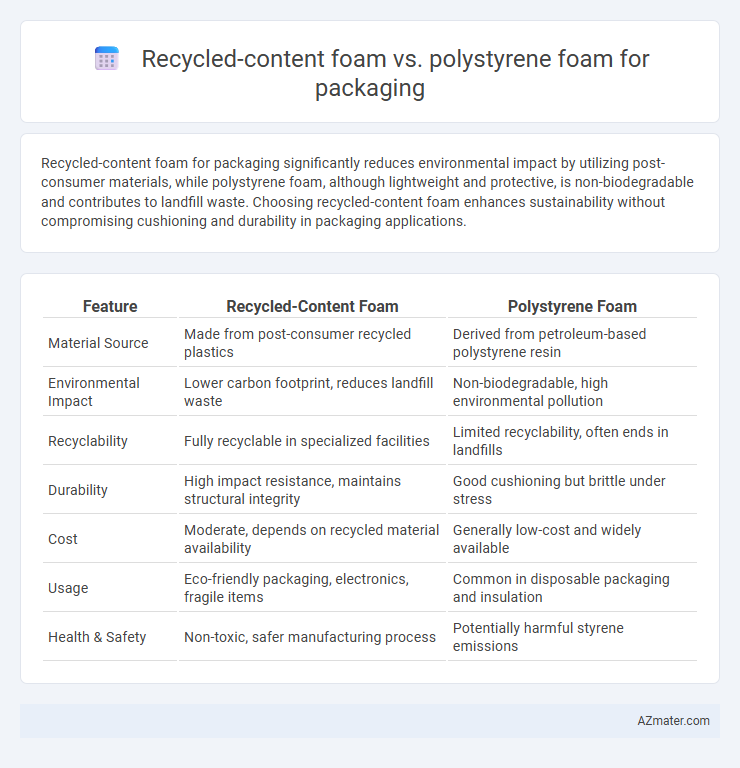Recycled-content foam for packaging significantly reduces environmental impact by utilizing post-consumer materials, while polystyrene foam, although lightweight and protective, is non-biodegradable and contributes to landfill waste. Choosing recycled-content foam enhances sustainability without compromising cushioning and durability in packaging applications.
Table of Comparison
| Feature | Recycled-Content Foam | Polystyrene Foam |
|---|---|---|
| Material Source | Made from post-consumer recycled plastics | Derived from petroleum-based polystyrene resin |
| Environmental Impact | Lower carbon footprint, reduces landfill waste | Non-biodegradable, high environmental pollution |
| Recyclability | Fully recyclable in specialized facilities | Limited recyclability, often ends in landfills |
| Durability | High impact resistance, maintains structural integrity | Good cushioning but brittle under stress |
| Cost | Moderate, depends on recycled material availability | Generally low-cost and widely available |
| Usage | Eco-friendly packaging, electronics, fragile items | Common in disposable packaging and insulation |
| Health & Safety | Non-toxic, safer manufacturing process | Potentially harmful styrene emissions |
Introduction to Sustainable Packaging Solutions
Recycled-content foam offers a sustainable alternative for packaging by reducing reliance on virgin materials and minimizing environmental impact compared to traditional polystyrene foam. Polystyrene foam, despite its excellent cushioning and insulation properties, presents significant environmental challenges due to its non-biodegradable nature and difficulty in recycling. Choosing recycled-content foam supports circular economy goals, lowers carbon footprints, and aligns with increasing consumer demand for eco-friendly packaging solutions.
Overview of Recycled-Content Foam
Recycled-content foam for packaging is made from post-consumer or post-industrial materials, reducing environmental impact by diverting waste from landfills. This eco-friendly alternative offers comparable cushioning, lightweight properties, and durability to traditional foams while supporting circular economy principles. Manufacturers increasingly use recycled-content foam to meet sustainability goals and regulatory requirements in packaging solutions.
Understanding Polystyrene Foam in Packaging
Polystyrene foam, widely used in packaging, offers excellent thermal insulation, lightweight properties, and shock absorption capabilities essential for protecting fragile goods. Unlike recycled-content foam, polystyrene foam is derived from petroleum-based styrene monomers, raising environmental concerns due to its non-biodegradability and limited recyclability. Innovations in polystyrene recycling and efforts to incorporate recycled content aim to reduce environmental impact while maintaining packaging performance standards.
Environmental Impact Comparison
Recycled-content foam significantly reduces landfill waste by repurposing existing materials, lowering the demand for virgin resources and decreasing carbon emissions associated with production. Polystyrene foam, derived from non-renewable petroleum, contributes to environmental pollution due to its non-biodegradable nature and challenges in recycling processes. Choosing recycled-content foam for packaging enhances sustainability by minimizing ecological footprint and promoting circular economy practices.
Performance and Durability Factors
Recycled-content foam typically offers improved environmental benefits while maintaining comparable cushioning and shock absorption performance to polystyrene foam in packaging applications. Polystyrene foam excels in rigidity and structural integrity, providing superior impact resistance and moisture barrier properties for long-term durability. Performance differences hinge on specific use cases, with recycled-content foam favoring sustainability and polystyrene foam prioritizing high-strength and consistent protection.
Cost Analysis: Recycled vs. Polystyrene Foam
Recycled-content foam packaging generally offers lower material costs compared to traditional polystyrene foam due to the use of reclaimed materials and reduced reliance on virgin petrochemicals. Polystyrene foam typically incurs higher production and disposal expenses linked to its petroleum base and environmental regulations. Cost savings with recycled foam also stem from lower landfill fees and potential tax incentives for sustainable packaging choices.
Regulatory Compliance and Industry Standards
Recycled-content foam for packaging often meets stringent regulatory compliance requirements such as EPA guidelines and international standards like ISO 14021, emphasizing environmental sustainability and reduced carbon footprint. Polystyrene foam, while widely used, faces increasing restrictions under regulations like the EU Single-Use Plastics Directive and various U.S. state bans due to its non-biodegradable nature and recycling challenges. Industry standards such as ASTM D6400 for compostability and ASTM D6866 for biobased content testing play a crucial role in validating recycled-content foam's compliance and market acceptance.
Market Trends and Consumer Preferences
The market for recycled-content foam in packaging is growing rapidly due to increasing consumer demand for sustainable and eco-friendly materials, driven by environmental regulations and corporate sustainability goals. Polystyrene foam remains prevalent due to its low cost and effective cushioning properties, but its environmental impact and challenges in recyclability have sparked a shift towards biodegradable and recycled alternatives. Consumer preferences are steadily favoring packaging solutions with lower carbon footprints and enhanced recyclability, prompting manufacturers to innovate with recycled-content foam that meets performance standards while reducing environmental harm.
Practical Applications in Packaging
Recycled-content foam offers eco-friendly packaging solutions by reducing waste and conserving resources, making it ideal for sustainable shipping of delicate electronics and fragile items. Polystyrene foam excels in lightweight cushioning and moisture resistance, commonly used for food containers and protective packaging due to its thermal insulation properties. Choosing between these materials depends on the balance between environmental goals and specific packaging performance requirements.
The Future of Eco-Friendly Packaging Materials
Recycled-content foam offers a sustainable alternative to traditional polystyrene foam by reducing landfill waste and lowering carbon footprints in packaging. Innovations in biodegradable additives and enhanced recyclability position recycled-content foam as a frontrunner in eco-friendly packaging materials for industries aiming to meet global environmental regulations. Advancements in material science continue to improve durability and protective qualities, ensuring recycled-content foam remains a viable and responsible choice for sustainable packaging solutions.

Infographic: Recycled-content foam vs Polystyrene foam for Packaging
 azmater.com
azmater.com